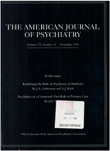Concordance between patients and informants on the personality disorder examination
Abstract
OBJECTIVE: Difficulties in the assessment of personality disorders and the burgeoning interest in axis II have led to increased use of informants when studying these conditions. The present study sought to evaluate the correspondence between patients and their informants on symptoms of personality disorders. METHOD: A total of 105 outpatients and knowledgeable informants were independently interviewed by using the Personality Disorder Examination, a widely used instrument for the full range of personality disorders. RESULTS: Diagnostic concordance between interviews was low (median kappa = -0.01), while correlations between dimensional scores were somewhat higher (median kappa = 0.36). Overall, patient interviews showed more pathology than interviews with informants. However, many of the symptoms obtained from informants were not reported by patients. CONCLUSIONS: These data suggest that patient- informant concordance for axis II disorders is poor for diagnoses but somewhat better for dimensional scores. There was no evidence that low agreement can be explained by patients attempting to present themselves in a favorable light. Further work is necessary to elucidate the reasons for discordance and determine which data source provides the most valid information.
Access content
To read the fulltext, please use one of the options below to sign in or purchase access.- Personal login
- Institutional Login
- Sign in via OpenAthens
- Register for access
-
Please login/register if you wish to pair your device and check access availability.
Not a subscriber?
PsychiatryOnline subscription options offer access to the DSM-5 library, books, journals, CME, and patient resources. This all-in-one virtual library provides psychiatrists and mental health professionals with key resources for diagnosis, treatment, research, and professional development.
Need more help? PsychiatryOnline Customer Service may be reached by emailing [email protected] or by calling 800-368-5777 (in the U.S.) or 703-907-7322 (outside the U.S.).



